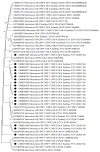Prevalence of Human Norovirus GII.4 Sydney 2012 [P31] between 2019 and 2021 among Young Children from Rural Communities in South Africa
- PMID: 37632024
- PMCID: PMC10458076
- DOI: 10.3390/v15081682
Prevalence of Human Norovirus GII.4 Sydney 2012 [P31] between 2019 and 2021 among Young Children from Rural Communities in South Africa
Abstract
Acute gastroenteritis (AGE) accounts for considerable morbidity and mortality in the paediatric population worldwide, especially in low-income countries. Human norovirus (HNoV), particularly GII.4 strains, are important agents of AGE. This study aimed to detect and characterise HNoV in children with and without AGE. Between 2019 and 2021, 300 stool samples (200 AGE and 100 without AGE) were collected from children below 5 years of age referred to the healthcare facilities of the rural communities of Vhembe District, South Africa. After detection using real-time RT-PCR, HNoV positive samples were subjected to RT-PCR and Sanger sequencing. Partial nucleotide sequences (capsid/RdRp) were aligned using the Muscle tool, and phylogenetic analysis was performed using MEGA 11. The nucleotides' percent identity among HNoV strains was compared using ClustalW software. A significant difference in HNoV prevalence between AGE children (37%; 74/200) and non-AGE (14%; 14/100) was confirmed (p < 0.0001). Genogroup II (GII) HNoV was predominant in AGE children (80%; 59/74), whereas most non-AGE children were infected by the GI norovirus genogroup (64%; 9/14). GII.4 Sydney 2012 [P31] strains were dominant (59%; 19/32) during the study period. A phylogenetic analysis revealed a close relationship between the HNoV strains identified in this study and those circulating worldwide; however, ClustalW showed less than 50% nucleotide similarity between strains from this study and those from previously reported norovirus studies in the same region. Our findings indicate significant changes over time in the circulation of HNoV strains, as well as the association between high HNoV prevalence and AGE symptoms within the study area. The monitoring of HuNoV epidemiology, along with stringent preventive measures to mitigate the viral spread and the burden of AGE, are warranted.
Keywords: GII and GI genogroups; GII.4 Sydney 2012 [P31]; GII4 Sydney 2012; acute gastroenteritis (AGE); asymptomatic; norovirus; symptomatic.
Conflict of interest statement
The authors declare no conflict of interest.
Figures



Similar articles
-
Genetic characterisation of Norovirus strains in outpatient children from rural communities of Vhembe district/South Africa, 2014-2015.J Clin Virol. 2017 Sep;94:100-106. doi: 10.1016/j.jcv.2017.07.005. Epub 2017 Jul 21. J Clin Virol. 2017. PMID: 28783578
-
Molecular epidemiology and genetic diversity of norovirus infection in children hospitalized with acute gastroenteritis in East Java, Indonesia in 2015-2019.Infect Genet Evol. 2021 Mar;88:104703. doi: 10.1016/j.meegid.2020.104703. Epub 2021 Jan 2. Infect Genet Evol. 2021. PMID: 33401005
-
Norovirus prevalence and estimated viral load in symptomatic and asymptomatic children from rural communities of Vhembe district, South Africa.J Clin Virol. 2016 Nov;84:12-18. doi: 10.1016/j.jcv.2016.09.005. Epub 2016 Sep 13. J Clin Virol. 2016. PMID: 27644014 Free PMC article.
-
Human norovirus contamination in water sources: A systematic review and meta-analysis.Environ Pollut. 2021 Dec 15;291:118164. doi: 10.1016/j.envpol.2021.118164. Epub 2021 Sep 13. Environ Pollut. 2021. PMID: 34534825
-
Current Status of Norovirus Infections in Children in Sub-Saharan Africa.J Trop Med. 2015;2015:309648. doi: 10.1155/2015/309648. Epub 2015 Nov 16. J Trop Med. 2015. PMID: 26649055 Free PMC article. Review.
Cited by
-
Temporal changes in the positivity rate of common enteric viruses among paediatric admissions in coastal Kenya, during the COVID-19 pandemic, 2019-2022.Gut Pathog. 2024 Jan 4;16(1):2. doi: 10.1186/s13099-023-00595-4. Gut Pathog. 2024. PMID: 38178245 Free PMC article.
-
Norovirus-Associated Gastroenteritis Vesikari Score and Pre-Existing Salivary IgA in Young Children from Rural South Africa.Viruses. 2023 Oct 30;15(11):2185. doi: 10.3390/v15112185. Viruses. 2023. PMID: 38005863 Free PMC article.
-
Epidemiological and molecular surveillance of norovirus in the Brazilian Amazon: description of recombinant genotypes and improvement of evolutionary analysis.Rev Inst Med Trop Sao Paulo. 2024 Apr 19;66:e22. doi: 10.1590/S1678-9946202466022. eCollection 2024. Rev Inst Med Trop Sao Paulo. 2024. PMID: 38656038 Free PMC article.
References
-
- Cannon J.L., Bonifacio J., Bucardo F., Buesa J., Bruggink L., Chan M.C.-W., Fumian T.M., Giri S., Gonzalez M.D., Hewitt J., et al. Global Trends in Norovirus Genotype Distribution among Children with Acute Gastroenteritis. Emerg. Infect. Dis. 2021;27:1438–1445. doi: 10.3201/eid2705.204756. - DOI - PMC - PubMed
Publication types
MeSH terms
Substances
LinkOut - more resources
Full Text Sources
Medical
Research Materials

